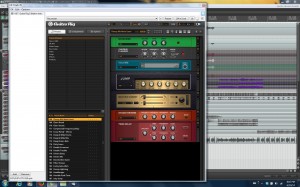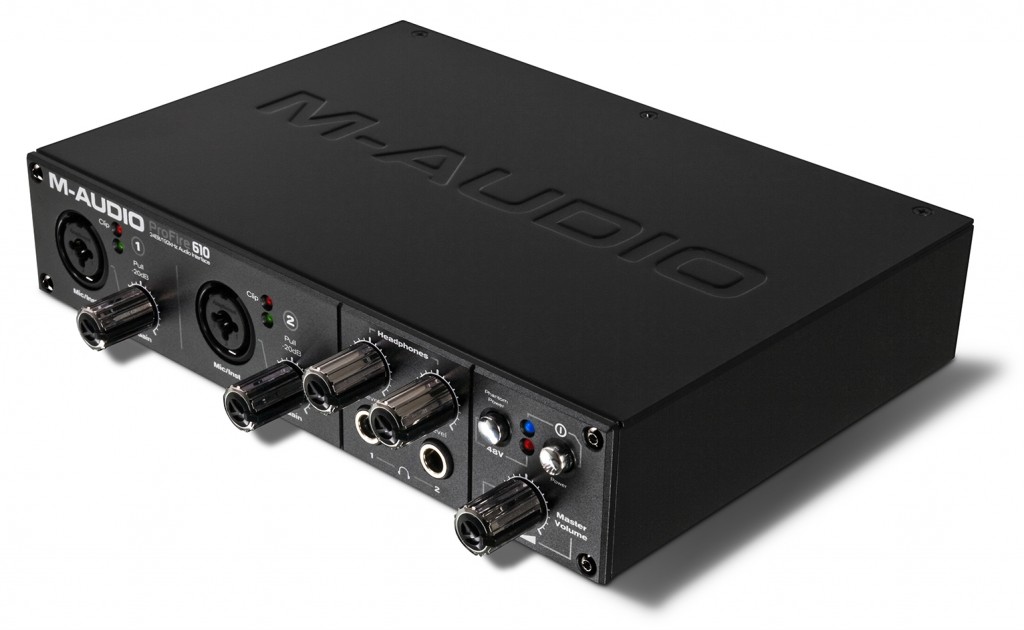The Recap
Over 20 years after I had last picked up an instrument to record I suddenly found myself with the basic capability to multitrack my guitar to a DAW running on my laptop. It was a pretty big discovery for me to realize that I already had what I needed to begin some very basic home recording. My existing laptop was bleeding edge in 2007 and had held up well enough till today (2014) to still be up to the task. I had a basic, but high quality expresscard stereo interface in the Echo Indigo IOx, a guitar amplifier with a line-out in the famed S&D Rockman x100, and a mix match of cables, mics, pedals, and other gear that I’m sure I would be able to use. Taking stock of my gear was like preparing for a trip. I was about to begin my Home Recording Odyssey.
In the first few days I just played around with making and recording sound while I continued exploring the rockband tracks for the Wings song that I had downloaded. (see earlier article). Some of the first things I did were very simple – just some relatively clean toned playing to give me some practice in arming tracks and hitting record – all very remedial. I had no idea what I was doing so each new thing I tried was just about building up familiarity and proficiency with the tools – like learning how to walk. Here’s a sample of some of those first couple of recorded tracks – bare bones for sure but very thrillinng at the time.
.
It all sounded okay – certainly within reason, but it became clear that the Rockman was probably the weak link in the chain. Traditionally noisy, it seemed “extra” noisy for some reason, and one of the channels was not working so I didn’t have true stereo out – a must for a Rockman which is known for its signature stereo chorus effect. But it was still pretty cool to be able to lay down some sample tracks along side the original Wings’ drum track inside Reaper. It was exciting enough that I considered grabbing a bass version off of ebay as well, (and was prepared to send them both to one of the few remaining Rockman repair gurus I found on the web) but the more I considered the noise they produced, the limitations of their sound, and added up the expense, I knew it was time to consider a proper recording interface. I would retire the Rockman and the Echo Indigo and find something with more features specific to home recording. It would be for the best
The Interface
There are a few basic technical and projected usage type questions you need to address before you buy (ie, firewire or USB, and the question of recording live drums requiring more inputs) but a very good all-you-need-for-now interface would be something like a Focusrite Scarlett 6i6 6 In/6 Out USB 2.0 Audio Interface With Two Focusrite Mic Preamps. Another option might be the M-Audio MTRACK Quad. What I needed and wanted was something that could handle high quality audio, have multiple inputs for guitar and mic recording, midi, and phantom power. I ended up with the firewire M-Audio Profire 610.
***Some general notes when buying products. It would seem that no matter what you look at in terms of products you will find negative reviews that can easily scare you away from making a purchase. You’ve right to be concerned in this age. Product life and support cycles are getting shorter, and the downward pressure on pricing from online retailers combined with very quick development cycles and short lead times have lead to many products being “beta” tested in real time after release to the market. We want products loaded with new features and low pricing – and we want tomorrow’s products today – and these things often run at cross purposes. The best you can do is a little research – try youtube for demos and then visit both official and non-official forums on the web to see what the down-low on any particular product is. You are apt to find lots of negative stuff no matter what. As a consumer you need to develop your own way to evaluate the criticisms and reviews of products you’ll read online – to separate the chaff from the wheat so to speak – or you’ll be completely paralyzed from moving ahead and buying anything. Case in point – had I read the reviews and the issues others had with the Profire 610 I would have never bought it. Everything from bugs, to driver incompatibility issues, to slow product support – all the horrors were there on the web. But for me the product has performed flawlessly and I could not be any more happy with it. Maybe I got lucky or maybe the noise brought on by the harbingers of doom was just that – noise. No matter what you do it will pay to do your research – but read everything critically. Critical evaluation is a skill set you need to develop if you want to find your way to the products that will best suit you and your needs.
Guitar Amplification
With the Profire 610 in my arsenal it was time to drag out my amp from its road-case – or so I thought. My problem was twofold: I lived in an urban condo with shared walls top to bottom and left to right. Because of a particularly noisy and inconsiderate neighbour who had already been the subject of noise complaints through the strata, I found myself more than a little gun shy about firing up my amp. Years ago I had seen some stuff about amp modeling software and wondered if this might be an option for me. So it was with HUGE skepticism that I began looking through the net to find something that would work for me. It took all of about two seconds. I immediately found free versions of Native-Instruments Guitar Rig 5 and IK Multimedia’s Amplitube 3 that were available in limited (stripped down) iterations, for unlimited trials. My initial skepticism was immediately quelled when my guitars sprang to life with screaming heavy metal thunder – all in the isolated environment of my tiny iphone headphones plugged into my M-Audion interface. It was another jaw on the floor moment. I could make noise – thunderous noise – and no one would hear it. Oh Joy!

With the new amp sims I had basic amplification and effects at my disposal with a small but nice selection of available presets. And it sounded…. great. Better than great. It sounded fantastically great. I sat there at my desk looking at my Mesa Boogie MK IIC+ in all it’s fabled glory – probably one of the most famous and best sounding boutique amplifiers ever produced – and yet it sat idle while I played through the simulated amplification software. I wont say that I didn’t miss playing through my amp but both Guitar Rig and Amplitube allowed me to get into the party — and it was a pretty damned good party. There’d be time for my Boogie later.
Back to the Project
So the task at hand was to record something – to initiate a project. I had chosen to cover Wings’ Let Me Roll It after discovering the ability to extract the multitrack files from the .mogg files that came with the Rockband video game. Knowing nothing about Reaper and its myriad of complexities and functions, I just dumped the multitracks into the DAW and prepared to track my own instruments in new tracks alongside the originals. The first thing I realized was that the timebase and time signature were set to default (which was 4/4 & 120 BPM). I decided to ignore them and treat the recording environment like a virtual tape (which I later learned I could have adjusted in the settings to change). I knew that I had to push forward and get something down and not get buried in the learning process. I was already surprised at the accelerated pace of the learning. Stuff that I had thought would take me days to research and learn within the Reaper workflow took minutes. I had been so accustomed to my old school style of home hobby recording and bouncing tracks back and forth between multiple tape recorders (in the 80’s) that I didn’t expect to complete anything – even a test project – at anything resembling a quick pace.
I dragged out my electric guitars, my bass, and mic’d up an acoustic with both an SM57 & an EV N/D357 about 2 inches from the soundhole. It took an whole evening, but one by one I managed to lay complete tracks (with no overdubs or fixes — had no idea how to do those yet). It was nearly 2:00am when I started cutting vocals, sitting at my desk hunched over the mic. I sang low and gentle so as not to wake the neighbours. By 4:00am I had a completed song. There was no mixing or treatment at this point in my learning. I knew nothing about levels or buses, or Fx. Everything I did was recorded and balanced (mixed) as I did it. Compression and EQ would come much later – I was just happy to have something resembling a song “on tape”. I rendered the track to .wav and loaded it on my iPhone. I had a song!
I was on such a high as I crawled into bed – careful not to wake my wife. The earbuds were on and I went to sleep with the song on endless repeat and my mind on fire with the excitement of the future. It wasn’t the only thing on fire though. My hands – specifically my fretting hand – burned both hot and cold with an intense pain and ache. I knew it was there, dormant, and it had returned with an intensity to match my enthusiasm in this moment of personal joy. You see -I had not played for over twenty years – essentially after a nerve injury forced me at the age of 21 to drop out of a Classical Guitar University Degree program and leave all my musical dreams and aspirations on the floor of time. It was soul crushing at the time, and I had been estranged from both playing and music in general, like a man in exile, for over two decades. But I was coming home. I was determined to come home and claim back my identity as a musician. Pain or not, I’d be damned if I was going to stop now. I heard my own voice singing the Paul McCartney line “Let me Roll It to you” in my mix… Too Right! I thought. I was going to roll it. When its got momentum you can’t stop a rock from rolling – Just like Sisyphus… I was going to Rock ‘N’ Roll – And if that rock rolled right back on-over me I was going to rock ‘n’ roll it right back up there. I’d celebrate the rolling – not the summit – and keep rockin’ no matter what. That’s what I was going to do, I thought. Just watch me!
Title Photo Credit: Flickr user wstryder, Source. CC. 2.0
Watch this site for a continuation of this series of articles on Home Recording.



[…] Check back for part two of this series of articles on home recording in the near future. […]
[…] all changed around 2013 when I discovered home recording for myself. A few small music projects followed on the heels of that discovery and soon thereafter all my gear and guitars […]